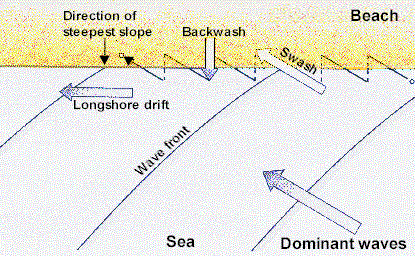
Longshore Drift: The transport of sediments, such as sand and gravel, along the coast at an angle to the shore which depends on the wind direction, waves and the backwash of waves. The initial waves moves sediment up the beach, then the backwash pushes it back down the beach. This creates a zig-zag movement of sediment on the coast. Large sediment is found updrift and the smaller sediment which is more usually moved is found downdrift.

Headward Erosion: Backwards erosion of material at the start of a river or stream. Gravel or soil at the source of the river are carried away causing the start of the river to move backwards as erosion takes place in the opposite direction of the flow of the river.
Coco:
ReplyDeleteFantastic mix of images and explanations !
Griff
Coco:
ReplyDeleteYour "headward erosion" is excellent...but should be with streams and stream erosion.
With the Oceans section you want "headland" erosion...which is the process of wave refraction making sea caves-arches stacks....
Griff